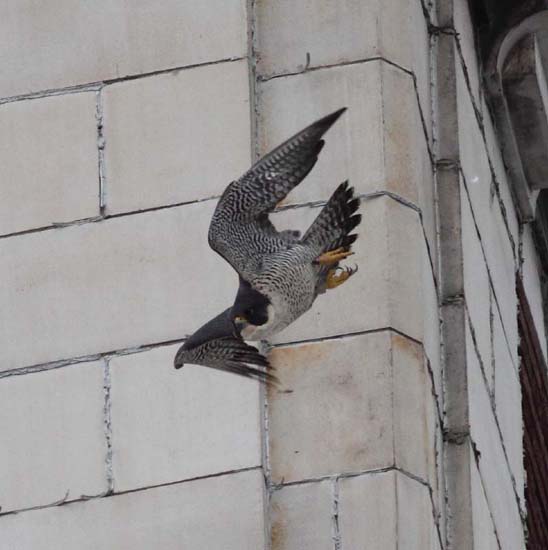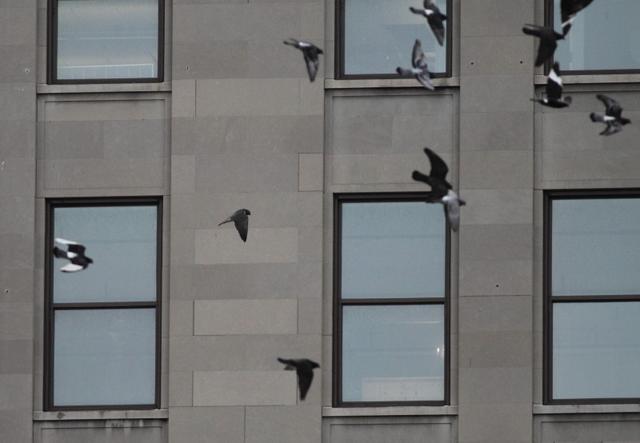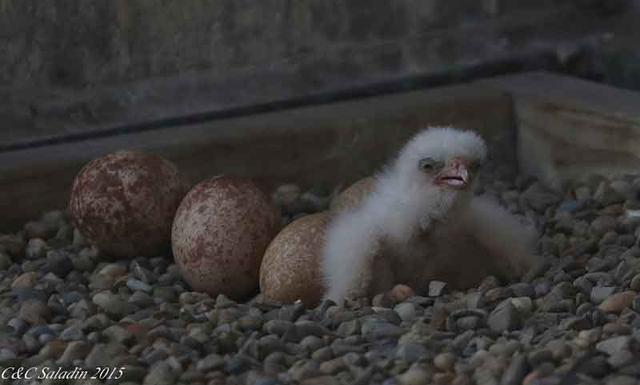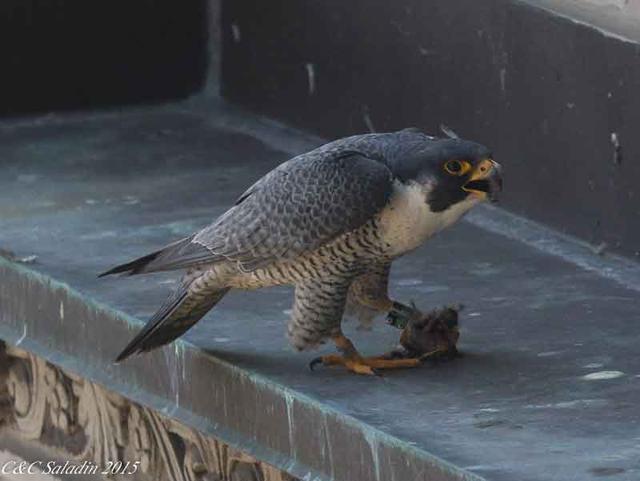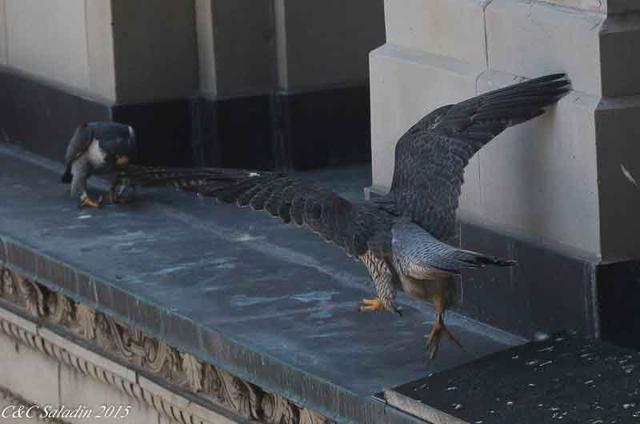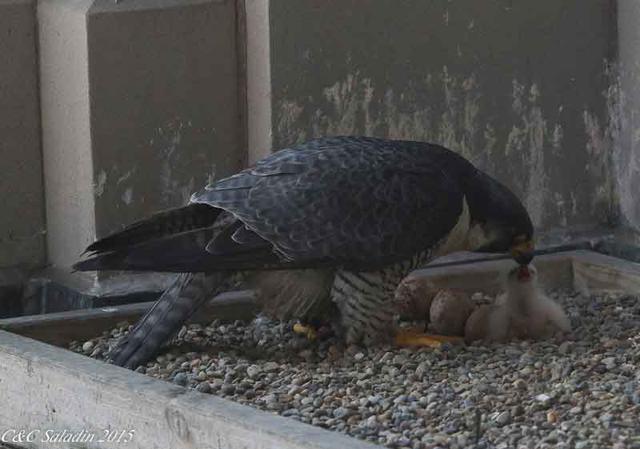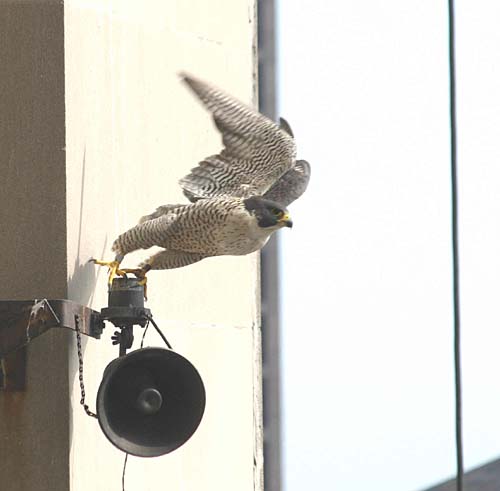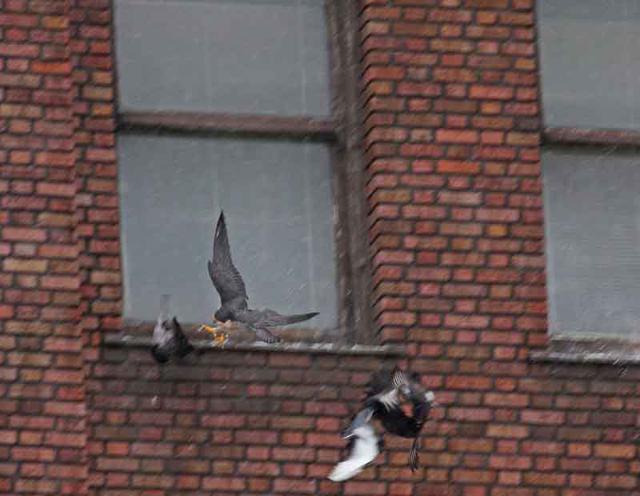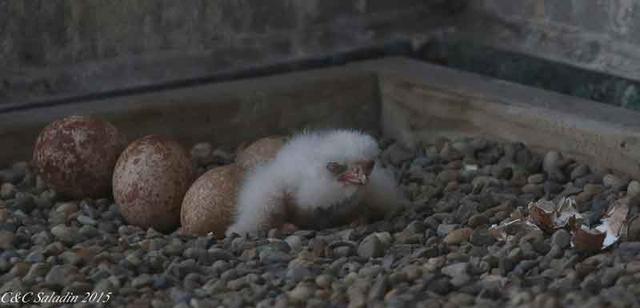FALCON FLASH......
Dateline: Cleveland, Ohio
May 18, 2015
Still only one eyass to report. Newton is an older female, age about 14 years, and experts report that fertility begins to decline as peregrine females reach the age of 12-13. However, we are very happy to have one eyass. Here he or she is at age 1 day. Volunteer nest monitor Mrs. Saladin reports: “Chick looks healthy, but of course wobbly at this age and needed to turn itself to lean against the eggs to stay upright after Newton took the prey out. Too cute”.
Although a newly hatched eyass doesn't require much food, Boomer is a wonderful provider. Here he is bringing in lunch.
Volunteers Mr. and Mrs. Saladin often watch the falcons hunt pigeons. The following pictures show courtship hunting for pigeons. Mr. and Mrs. S tell us, “We watched the pair hunt together ……. They perched up on the Bank ledge near the top as the pigeons accumulated on the window sills below them. The female repeatedly dove down against the building toward them……..
and as the pigeons flushed her mate would join in and chase them out over the square. ……. some of the pigeons were a bit slow leaving the window ledges and the female nearly snagged one………
That day, even with two raptors hunting together, they did not catch a pigeon while Mr. and Mrs. Saladin were watching. According to the Canadian Peregrine Foundation, the average peregrine is successful in catching its prey only 2-4 times in 10 attempts. In the following video, you can see a tactic that the slow
flying pigeon uses to defend itself from the fastest creature on earth:
Newton and Boomer catch plenty of food, and their one little eyass is being very well fed. Believe it or not, in 6 weeks this little guy will grow to be as large as his or her parents and will be flying!
Might any of the other eggs hatch????? To watch the falcons live go to: http://www.falconcam-cmnh.org/news.php
Our thanks to the Cleveland Museum of Natural History for sponsoring the FalconCams.
Photo of a female launching off the old speaker is courtesy of former nest monitor Mr. Scott Wright. Other photos are courtesy of Mr. and Mrs. Saladin, volunteer peregrine nest monitors.
Click here to read what happpened earlier.
In the following picture, Newton rushes to take the food from Boomer.
An “eyass” eats the same food that adult falcons eat, but Newton tears the meat into very small pieces.
The eyass will grow and change very fast for the next 6 weeks. Check out a picture guide and information about eyass growth at The Canadian Peregrine Foundation:
While Mrs. Saladin watched, Newton took the prey to “cache” it at a nearby building ledge. This is a wise peregrine practice in which they store food for future use at a different location. The following picture shows the cache location with Newton on top of one of the pillars protruding from the roof and Boomer perched on the left corner. They are making sure there will be plenty of food for their little one.
You probably know by now that peregrine falcons are predators and their prey is other birds. Why do they like cities so much? Lots of birds!
In a man-made environment, the numbers within species may get out of balance. Cities sometimes have too many pigeons, which can cause a mess and can even cause disease. Some cities and building owners try to limit the number of pigeons. Before the peregrines moved in, the owners of Newton and Boomer’s skyscraper installed a system of loudspeakers, wiring and brackets as a “pigeon repellant system”. The idea was that if loud noises were playing, the pigeons would go away. It didn’t work. A longtime falcon fan tells us, " Today, no methods of pigeon control are in use. Staff from Terminal Tower building maintenance says the falcons do an excellent job of keeping the pigeons away from the building, which is one reason building management is supportive of the continued presence of the Peregrine Falcon nest site." At least the old speakers were good for something – for years, the falcons used them as convenient perches and launching pads.
.........it created a frenzy, as some of the pigeons just about flew into one another trying to escape”. According to the Canadian Peregrine Foundation, the average peregrine is successful in catching its prey only 2-4 times in 10 attempts.
Click here to read what happpened next.

